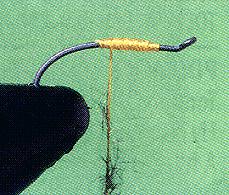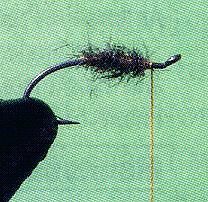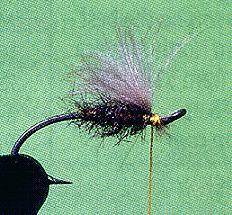CDC/Soft Hackle Hybrids, Part 2
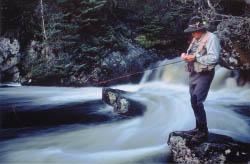
By Chris Marshall
A Traditional Soft-Hackled Wet
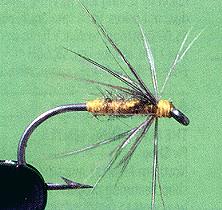
This is my favourite soft-hackle. It was used to imitate early season up-wing
flies on Yorkshire rivers. In Canada and the USA it is an excellent pattern
for olive-bodied, grey-winged ephemerellas, such as subvaria and related
flies in the northeast. The following recipe is taken from Pritt's,
North Country Flies:
Body: Yellow silk, dubbed sparsely with the fur of the
water-rat.
Hackle Hackled feather from the inside of a waterhen's wing
(undercovert).
Modern tyers should use mole in place of water-rat, and a 6/0 tying thread can be
substituted for pure silk, although silk is preferable. Tying instructions for the
traditional pattern are incorporated in the instructions for the CDC version.
The word "bloa" is a north country word used to refer to the grey-blue-black
colour found in clouds, bruises, and in the feathers of a variety of wild birds.
Eventually it came to be used as a name for the feathers of this colour and,
eventually to the flies themselves (both naturals and artificials), as in "Poult
Bloa", "Snipe Bloa", and "Little Olive Bloa".
The CDC Soft-hackle Combination
These are simply traditional soft-hackled patterns with a CDC wing added
prior to winding in the hackle. However, bodies can be made with synthetic
thread and dubbing (SLF is excellent) instead of silk. Any soft hackle feather
can be used, particularly breast feathers, undercoverts, some flank and back
feathers of wild birds. The feathers of domestic fowl, though, have barbules
which are generally too fine to give the characterisic effect provided by the
thicker barbules of wild birds. Similarly, rather than rigidly copying the
traditional patterns, colours can be chosen to match whatever naturals the
tyer desires.
Recipe
The following recipe is for a fly intended more as a floater than a sinker. When
dry, it will float relatively high in the water when wet it will sink slowly.
Copnsequently, the CDC is a dense oiler puff and the hook is a curved-shank,
lightweight emerger hook. For a fly intended primarily as a sinker - that is, one
which will sink quickly when wet and float inly in the film when dry, the CDC
wing should be much sparser and the hook heavier wire.
Hook: Curved shank emerger hook, such as Partridge GRS7MMB.
Thread: Yellow silk.
Body: Yellow silk, dubbed over lightly with mole's fur.
Wing: Dense CDC oiler feather, natural gray.
Hackle: Waterhen (coot) underdovert. No more than two
turns.
The colour of the body can be varied between yellow and grey by increasing or
decreasing the density of the dubbing. However, the best combination, especially
for the Hendrickson and similar flies is a fine veiling allowing the yellow silk to
show through.
|




